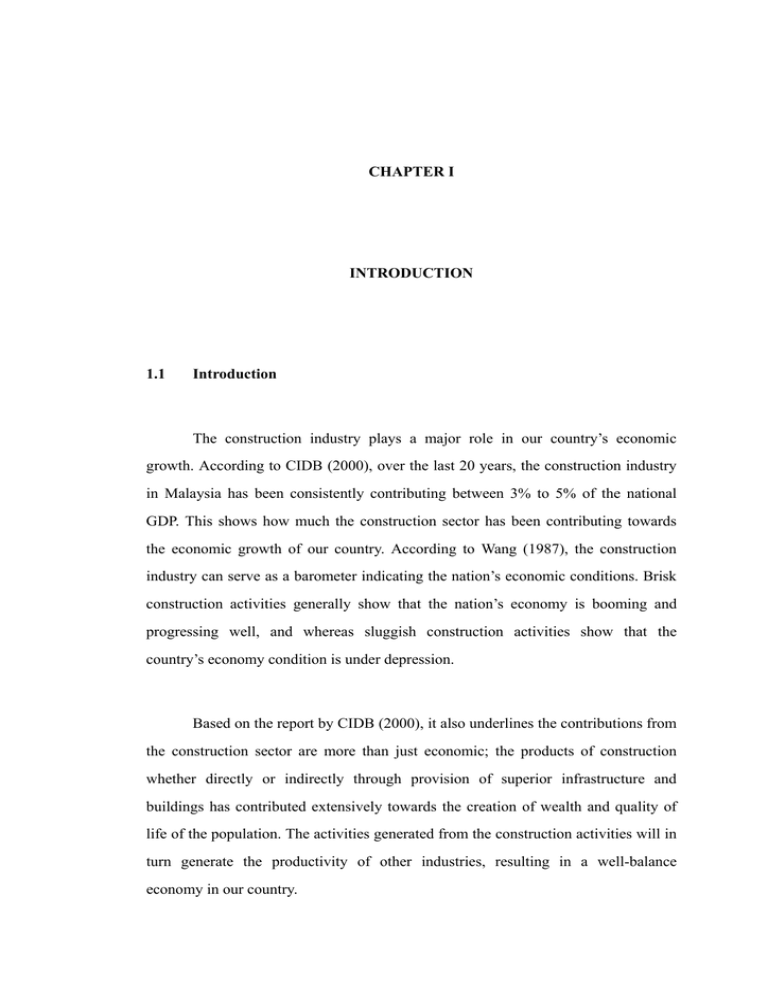CHAPTER I INTRODUCTION 1.1
advertisement

1 CHAPTER I INTRODUCTION 1.1 Introduction The construction industry plays a major role in our country’s economic growth. According to CIDB (2000), over the last 20 years, the construction industry in Malaysia has been consistently contributing between 3% to 5% of the national GDP. This shows how much the construction sector has been contributing towards the economic growth of our country. According to Wang (1987), the construction industry can serve as a barometer indicating the nation’s economic conditions. Brisk construction activities generally show that the nation’s economy is booming and progressing well, and whereas sluggish construction activities show that the country’s economy condition is under depression. Based on the report by CIDB (2000), it also underlines the contributions from the construction sector are more than just economic; the products of construction whether directly or indirectly through provision of superior infrastructure and buildings has contributed extensively towards the creation of wealth and quality of life of the population. The activities generated from the construction activities will in turn generate the productivity of other industries, resulting in a well-balance economy in our country. 2 Construction industry basically consists of various processes, involves many parties and different stages of work. It involves the participation of various parties from various sectors in order to ensure the efficiency of the construction work carried out. The efficiency and success of construction development and activities depends heavily on the quality of managerial and organizational performance plus the effective co-ordination through good teamwork from the different parties. It is therefore obvious that the development of the construction industry can only be achieved if every team members play effective roles in their work. The construction industry involves the participation of seven various sectors. This includes the Client/Developer Sector, the Consultant Sector which includes project management consultants, planners, architects, engineers, quantity surveyors, land surveyors and other specialist consultants, the Contractor Sector which also includes the main contractor, specialist and nominated sub-contractors, The Material and Equipment Supplier Sector, Manpower Sector, which includes unskilled, semi-skilled and skilled workers, The Finance Sector which involves banks, finance and credit companies and lastly, the Approving Sector, which involves the local authorities, state and federal government. The efficiency and productivity of the industry depends largely on how the various sectors can jointly co-operate and try to understand each others’ needs and problems. However, the industry is not without weaknesses. More often than not, the challenges often occurs in the area of productivity, efficiency of work, quality of work and most importantly, the delivery of work. Currently, we can see that our country’s construction industry is still very comfortably using labour intensive and low technology methods of construction. The intensive use of foreign unskilled workers and low technology equipment and out-of-dated construction methods, has eventually caused low productivity and efficiency of work at construction site. As a result this has lead to unproductive practices and initially contributes to the late 3 delivery of work. According to Ismail (2001), in the 7th Malaysia Plan, 800,000 units of houses has been planned and out of that figure, 585,000 units or 73.1% were planned for low and medium cost houses. The disappointing fact is that, only 20% of completed houses were reported throughout the nation, despite numerous incentives and promotions to encourage developers to venture into such housing category. What has gone wrong? Waleed et al. (2003) reported that, the announcement of the 8th Malaysia Plan with the planning of 600,000 to 800,000 low and medium houses throughout the nation is indeed welcoming news to the population of Malaysia, especially to the middle and low income groups. However, it is undoubtedly an uphill task to accomplish such target with the current conventional building system currently practiced widely by the construction industry in our country. Therefore, the former system must be reviewed and better still replaced with a new system, which has better advantages in terms of improving productivity, indoor quality, improvement of work durability and efficiency and overall cost reduction. The introduction of the Industrialised Building System (IBS) with the promise of improving productivity rate, lowering construction costs and meeting the growing demand for affordable housing is indeed welcoming news to our country’s construction industry. In other word, the awareness of current trends and latest construction technology and innovation is essential in order to survive in the competitive market. 4 1.2 Problem Statement With the ongoing construction trend in Malaysia, that is still very comfortably using labour intensive and low technology methods of construction, this has initially lead towards low productivity and inefficiency of work at construction site. Moreover, with the Government’s call for more affordable housing, the construction industry has had to fulfil national housing and commercial needs which has eventually led to devastating compromise in quality of work. The highly dependency on unskilled and cheap foreign workers has definitely contributed to low productivity of work, because although they may be cheap, but they are not efficient and cause high wastage. The quality of work has also been terribly affected due to unskilled working method. After completion defects, structural failures and design inadequacies are some of the tell-tale sign of the current construction scenario in our country. According to CIDB (2000), complaints made by consumers through national media and to the authorities are some of the numerous indications of low quality of work. At the end, these will lead to decreased quality of life in uncomfortable and unfriendly environments. Figure 1.1 shows the scenario of our construction industry today. 5 Untrained Labour Trained Labour FACTORY Labour Intensive IBS Trained Personal Construction Projects - Lean / sustainable projects - Manufactured buildings - Not labour intensive Figure 1.1: The scenario of our construction industry today. Based on Figure 1.1, we can see that our construction industry’s highly dependency on untrained labours has led to the high usage of unskilled and cheap foreign workers. This has prompted the current construction industry to be labour intensive, due to the high usage of unskilled workers in the construction field. Taking into account of the high usage of foreign unskilled workers at site, it is difficult for the construction sector to achieve high productivity of work at site. However, if we were to introduce trained workers into the construction projects, we can achieve high productivity and efficiency of work, since the workers are able to carry out the work at site skilfully and effectively. These skilled and trained workers are currently trained in small groups by our local Construction Industry Development Board (CIDB) and Institut Kemahiran MARA (IKM). Therefore, when the IBS components arrive at site from the factory, the trained labours will be able to carry out the work at site effectively and efficiently. At the end of the day, the trained labours can help to achieve the target of producing more lean and sustainable projects, emphasize on constructing more manufactured buildings and most importantly focussing on the target of constructing construction projects 6 that are less labour intensive. Although the long-introduced Industrialised Building System (IBS) has promised to solve and improved the current construction method and scenario in our country, but the IBS method has been low in gaining popularity, partly due to lack of awareness and coordination among the relevant parties. Currently, the level of usage of IBS method is very low as compared to the conventional methods in building construction. In spite of its many benefits, the different perceptions among the construction players and practitioners towards its application in construction industry has led to the low usage of IBS components in the construction industry. Moreover, the benefits of IBS applications in the construction industry has yet to be known and uncovered due to lack of research studies conducted in the Malaysia’s construction perspective. Our local construction players are still in doubt of the efficiency of IBS method of construction as compared to the conventional method. The question to how much can the IBS method contributes towards reducing the total construction period, the efficiency of the assembling and erection processes at site and the production stage still lingers on and remain unanswered. At the end of the day, the IBS method remains unknown and unfamiliar to the local construction industry. Currently, public buildings such as schools in Malaysia are still widely constructed using the usual conventional Cast-In-Situ method. Many problems are associated with the conventional method, since the traditional brick and mortar give low and inconsistency quality since workmanship plays the main role, in which again relying on the skills of the foreign unskilled workers. With poor quality control at site, common problems such as project delay and possible monetary losses are a constant headache for the Client. Late delivery of work will often resulted in late occupancy of the building, and this often caused insufficient public facilities to the students and 7 teachers, and thus providing a conducive studying environment to the students is normally out of the question. It is hoped that the precast technology can bring out the tremendous potential towards productivity improvement as it encompasses aspects of standardisation, highly controlled and quality precast components which complements the various programs to increase productivity and quality control through the adoption of Modular Coordination (MC) and Industrialised Building System (IBS). 1.3 Objectives of Study The objectives of this study are as follows: (i) To achieve faster construction by reducing overall construction time, utilizing IBS method. (ii) To propose a new conceptual school building using standard IBS components, replacing the existing JKR conventional school buildings. (iii) To identify the generality for the processes in an IBS scheduling. (iv) To identify ways to integrate IBS method into the scheduling of school buildings. 8 1.4 Scope of Study The scope of this study is focused to building construction, especially involving public projects such as school construction. The purpose of this study is to determine whether the Industrialised Building System (IBS) can be implemented into the construction of public projects in our country, especially in reducing the overall construction period.




